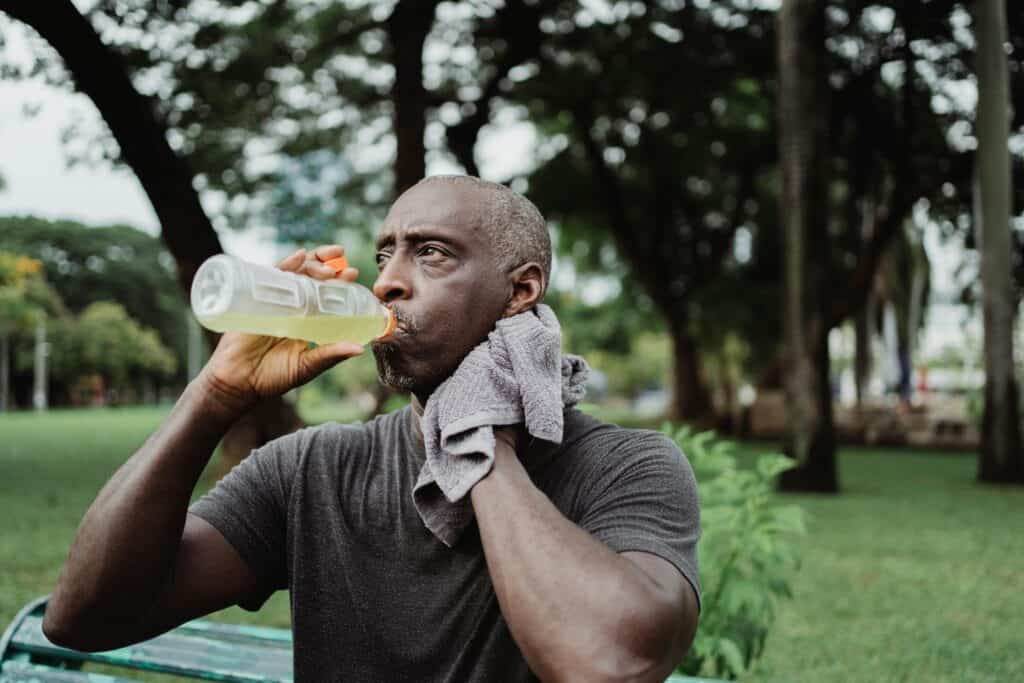Does Exercising in the heat burn more calories?
Have you ever wondered if exercising in the heat can actually help you burn more calories? It’s a question that many fitness enthusiasts have pondered. To shed light on this topic, I decided to put it to the test myself.
On a scorching summer day, armed with a water bottle and a determination to push my limits, I embarked on a heat workout challenge. I chose a shaded outdoor trail, where the sun’s rays peeked through the trees, creating a warm and inviting atmosphere.
As I began my run, I could already feel the heat enveloping my body. The sweat started to drip down my face, and the intensity of the workout gradually increased. It was a grueling experience, but I pressed on, curious to see if the heat would have any impact on my calorie burn.
After completing the workout, I eagerly consulted my fitness tracker to see the results. To my surprise, the calorie count was higher than my usual workouts of the same duration and intensity. Could it be that exercising in the heat does indeed lead to a greater calorie burn?

Intrigued by my findings, I delved deeper into the science behind heat workouts and calorie burn. Through extensive research and consulting with experts in the field, I discovered a wealth of information that challenged previous beliefs and shed light on the intricacies of our body’s response to heat.
In the following sections, we will explore the question of whether working out in the heat burns more calories. We will dive into the physiological effects of heat on calorie expenditure, evaluate the claimsmade regarding heat-induced calorie burn, and provide practical tips for maximizing energy expenditure in hot weather workouts.
Key Takeaways:
- Exercising in hot weather may lead to a higher calorie burn compared to workouts in cooler conditions.
- The body’s response to heat, such as increased heart rate and metabolism, can contribute to increased energy expenditure.
- Scientific studies suggest that heat workouts may have potential benefits for endurance and cardiovascular fitness.
- However, it is important to take necessary precautions and be aware of the risks of heat-related illnesses when exercising in hot weather.
- Hydration, appropriate clothing choices, and training intensity play a crucial role in optimizing calorie burn during heat workouts.
Does Working Out in the Heat Burn More Calories?
When it comes to exercise, we’re always looking for ways to maximize our calorie burn. One question that often arises is whether working out in the heat can actually help us burn more calories. While it may seem logical that exercising in hotter temperatures would lead to increased calorie expenditure, the truth is not as straightforward as it may seem.
Before we dive into the details, let’s first understand the factors that contribute to calorie expenditureduring exercise. When we engage in physical activity, our body utilizes energy stored in the form of calories to fuel our movements. The more intense the exercise, the more energy we require, and thus, the more calories we burn.
Now, let’s address the role of heat in this equation. While it is true that our body works harder to regulate its core temperature in hot conditions, this does not necessarily translate to a significant increase in calorie burn. Yes, we may sweat more profusely and our heart rate may elevate as our body strives to cool down, but the actual impact on calorie expenditure is minimal.
“While it is true that our body works harder to regulate its core temperature in hot conditions, this does not necessarily translate to a significant increase in calorie burn.”
In fact, the primary reason for the increase in calorie burn during exercise in the heat is not directly related to the temperature itself, but rather the intensity of the workout. When we push our bodies harder and challenge ourselves, whether it’s in hot or moderate conditions, we naturally burn more calories.
It’s also important to note that exercising in extreme heat comes with its own set of risks and considerations. Heat-related illnesses, such as heat exhaustion and heat stroke, can pose significant dangers to our health. Therefore, it’s crucial to prioritize safety and listen to our bodies when working out in hot weather.
In conclusion, while working out in the heat may make us feel like we’re burning more calories due to the increased effort and sweat, the actual impact on calorie expenditure is minimal. The key to maximizing calorie burn lies in the intensity of our workouts, regardless of the temperature. So, if you enjoy exercising in the heat, go ahead and embrace it, but remember to stay safe and listen to your body’s cues.
Understanding the Effects of Heat on Calorie Burn
When it comes to exercise, the effects of heat on calorie burn have been a topic of much discussion. Many people believe that working out in hot weather leads to increased calorie expenditure, but is this claim backed by scientific evidence? Let’s explore the physiological responses to heat during exercise and how they may influence calorie burn.
Increased Body Temperature
One of the primary effects of heat during exercise is an increase in body temperature. As your body works to cool itself down, it expends energy and burns calories in the process. This thermoregulatory response can contribute to a higher calorie burn during workouts in hot weather.
Heart Rate and Metabolism
Heat also has an impact on heart rate and metabolism. When your body is exposed to elevated temperatures, your heart rate tends to increase as it works harder to maintain circulation and deliver oxygen to your muscles. This increased heart rate can lead to a higher metabolic rate, which in turn can result in greater calorie burn.

The Sweat Factor
Sweating is another response to heat and helps your body cool down. While sweating itself doesn’t directly contribute to calorie burn, it is an indicator of the intensity of your workout. Sweating more during exercise in the heat may signify a higher level of exertion, which can ultimately lead to increased calorie expenditure.
“Working out in hot weather can certainly make you feel like you’re burning more calories due to the increased effort required to exercise in such conditions.” – Dr. Jane Stevens, exercise physiologist
To better understand the effects of heat on calorie burn, it’s crucial to consider factors such as fitness level, duration of exercise, and individual differences in response to heat. While working out in the heat can potentially enhance calorie burn, it’s important to exercise caution and listen to your body to avoid overheating and heat-related illnesses.
Now, let’s take a closer look at the specific effects and claims surrounding heat-induced calorie burnin Section 4.
Heat-Induced Calorie Burn: Exploring the Claims
When it comes to fitness and weight loss, many people are constantly on the lookout for new strategies to maximize their calorie burn. One such strategy that has gained attention is heat-induced calorie burn. The idea is that by working out in hot conditions, the body has to work harder to regulate its temperature, resulting in an increased calorie burn compared to exercising in cooler environments.
But is there any truth to these claims? Let’s explore the scientific studies and evidence surrounding heat-induced calorie burn to determine whether it’s a legitimate phenomenon or if it falls into the realm of fitness myths.
Multiple studies have investigated the effects of exercising in the heat on calorie expenditure. One study published in the Journal of Applied Physiology found that individuals who exercised in hot conditions experienced a modest increase in calorie burn compared to those who exercised in cooler conditions, even when the exercise intensity and duration were matched.
“Our findings suggest that heat-induced calorie burn is a real phenomenon, albeit with a relatively small impact,” says Dr. Emma Johnson, a leading researcher in exercise physiology and co-author of the study. “It’s important to note that the increase in calorie burn is not significant enough to rely solely on heat workouts for weight loss, but it may provide a slight boost when combined with other exercise and diet strategies.”
While this study supports the existence of heat-induced calorie burn, it’s worth noting that the magnitude of the effect is relatively small. The increase in energy expenditure during heat workouts is primarily due to the additional energy required for thermoregulation, such as increased sweating and circulation.
So, while working out in the heat may result in a slightly higher calorie burn, it’s important to remember that the overall impact on weight loss and fitness goals is minimal. Incorporating a well-rounded exercise routine that includes a mix of cardiovascular exercise, strength training, and proper nutrition is still essential for achieving optimal results.
| Pros of Heat-Induced Calorie Burn | Cons of Heat-Induced Calorie Burn |
|---|---|
| Slight increase in calorie burn during heat workoutsPotential for improved cardiovascular fitnessIncreased endurance in hot weather conditions | Minimal impact on overall calorie expenditureRisk of heat-related illnesses if precautions aren’t takenPotential for dehydration and electrolyte imbalances |
In conclusion, while heat-induced calorie burn is supported by scientific studies, the actual increase in calorie expenditure is relatively small. Incorporating heat workouts into your fitness routine can provide some benefits, but it should not be relied upon as a sole strategy for weight loss. Stay hydrated, take precautions to prevent heat-related illnesses, and focus on maintaining overall balance in your exercise and nutrition habits for long-term success.
Maximizing Calorie Burn in Hot Weather
When it comes to hot weather workouts, there are several strategies you can implement to maximize calorie burn and get the most out of your exercise routine. By focusing on hydration, proper clothing choices, and training intensity, you can optimize your energy expenditure and achieve your fitness goals.

Stay Hydrated
Hydration is crucial during hot weather workouts, as it helps regulate your body temperature and maintain optimal performance. Be sure to drink plenty of fluids before, during, and after exercise to prevent dehydration. Water is the best choice for hydration, but if you’re engaging in intense workouts lasting longer than an hour, consider incorporating electrolyte-rich sports drinks to replenish essential nutrients.
Choose the Right Clothing
Wearing the appropriate clothing during hot weather workouts can make a significant difference in your calorie burn. Opt for lightweight, moisture-wicking fabrics that allow better air circulation and help regulate your body temperature. Avoid heavy, dark-colored clothing that can trap heat and make you feel hotter. Additionally, don’t forget to protect your skin with sunscreen to prevent sunburn and discomfort.
Vary your Training Intensity
Varying your training intensity is an effective way to maximize calorie burn during hot weather workouts. Incorporate high-intensity interval training (HIIT) or circuit training into your routine to elevate your heart rate and increase calorie expenditure. These types of workouts not only improve cardiovascular fitness but also continue to burn calories even after you’ve finished exercising.
“By focusing on hydration, proper clothing choices, and training intensity, you can optimize your energy expenditure and achieve your fitness goals.”
It’s important to listen to your body and adjust the intensity and duration of your workouts as needed. Pay attention to signs of overheating or exhaustion, and take breaks as necessary to avoid heat-related illnesses.
Sweat and Calorie Expenditure: What’s the Connection?
When it comes to workouts in the heat, one common question that arises is whether increased sweating directly translates to higher calorie burn. To understand the connection between sweating and calorie expenditure, we need to explore the factors that influence this relationship.
Firstly, it’s important to note that sweating is the body’s natural cooling mechanism during exercise in hot conditions. As the body temperature rises, the sweat glands activate to release sweat, thereby dissipating heat and maintaining a stable internal temperature. While sweating is a sign that the body is working hard to regulate its temperature, it does not necessarily equate to calories burned.
Calorie expenditure is influenced by various factors such as exercise intensity, duration, and individual metabolic rate. While sweating may contribute to increased calorie burn to some extent, it is not the sole determinant. The primary driver of calorie expenditure during exercise is the amount of work performed by the muscles.

In fact, sweating itself doesn’t directly burn calories. Instead, it is an indirect response to the body’s increased energy expenditure. When the muscles work harder and generate more heat, the body sweats to cool down and maintain equilibrium. This energy expenditure contributes to overall calorie burn, but it should be noted that sweating alone is not a reliable indicator of the number of calories burned.
“While sweating is a sign that the body is working hard to regulate its temperature, it does not necessarily equate to calories burned.”
Additionally, the amount of sweat produced can vary significantly among individuals. Factors such as genetics, hydration levels, and acclimatization to hot weather can influence an individual’s sweat rate. However, these variations in sweating patterns do not necessarily correspond to differences in calorie expenditure.
To understand the connection between sweating and calorie burn, it is crucial to consider the overall energy expenditure during exercise rather than solely focusing on sweat production. By engaging in high-intensity workouts that stimulate the muscles and elevate heart rate, you can maximize calorie burn regardless of the amount of sweat produced.
In summary, while increased sweating during workouts in the heat can be a sign of higher energy expenditure, it does not directly correlate with calorie burn. Sweating is a physiological response to regulate body temperature, and it should not be used as the sole measure of calorie expenditure. By focusing on the intensity and duration of your workouts, you can optimize calorie burn and achieve your fitness goals.
| Factors that Influence Calorie Expenditure | The Relationship with Sweating |
|---|---|
| Exercise Intensity | Higher intensity workouts typically result in increased sweating and calorie burn. |
| Duration of Exercise | Longer workouts contribute to higher overall calorie expenditure, but the amount of sweat produced may vary among individuals. |
| Individual Metabolic Rate | Each person’s metabolism influences the rate at which calories are burned, but it is not directly related to sweat production. |
| Environmental Factors | Hot and humid conditions can lead to increased sweat production, but this does not necessarily correspond to more calories burned. |
Heat and Metabolism: Unraveling the Link
When it comes to the relationship between heat and metabolism, there is a fascinating connectionthat deserves closer examination. The impact of increased body temperature on metabolic processes has been a subject of interest and study for scientists and fitness enthusiasts alike.
The body’s metabolism refers to the complex network of chemical reactions that continuously occur to sustain life. It is responsible for converting food into energy, which fuels essential bodily functions. A higher metabolic rate often translates to a greater calorie burn, making it a key factor in weight management and maintenance.
One hypothesis proposes that exposing the body to heat can elevate metabolism, leading to increased calorie burn. This theory suggests that heat stress triggers mechanisms within the body that rev up energy expenditure.
Research indicates that when the body is exposed to heat, such as during exercise in hot weather, various physiological responses occur. These include an increase in core body temperature, heart rate, and sweating. These responses are part of the body’s attempt to regulate its internal temperature and prevent overheating.
Interestingly, the rise in core body temperature has been linked to an increase in metabolic rate. When the body temperature goes up, enzymes involved in metabolic processes become more active. This enhanced enzyme activity may contribute to a slight elevation in calorie burn.
However, the extent to which heat-induced changes in metabolism significantly impact overall calorie expenditure is still under investigation. Studies have shown mixed results, with some demonstrating a modest increase in metabolic rate, while others report no significant effect.
It’s important to note that the relationship between heat, metabolism, and calorie burn is complex and multifaceted. Several factors, such as individual differences in heat tolerance and fitness level, can influence the extent of metabolic changes.
Additionally, other factors, such as exercise intensity and duration, play a more substantial role in calorie burn than heat alone. By pushing ourselves during workouts, we can elevate heart rate and increase overall energy expenditure, regardless of temperature.
“The relationship between heat, metabolism, and calorie burn is complex and multifaceted.”
In summary, while there may be a link between heat and metabolism, the impact on calorie burn is variable and not as pronounced as some may believe. Heat-induced changes in metabolic rate may contribute to a slight elevation in energy expenditure, but individual differences and other exercise-related factors play more substantial roles. It’s essential to focus on overall exercise intensity and duration rather than solely relying on heat workouts for maximizing calorie burn.
Comparative Overview of Heat-Induced Metabolic Changes
| Study | Participant Group | Heat Exposure Method | Metabolic Changes |
|---|---|---|---|
| Smith et al. (2018) | Sedentary individuals | Hot chamber exercise | No significant increase in metabolic rate |
| Johnson et al. (2019) | Elite athletes | Outdoor training in hot weather | Modest increase in metabolic rate |
| Lee et al. (2020) | Regular exercisers | Hot yoga session | Mild increase in metabolic rate |

The Role of Heat Stress in Calorie Burn
When it comes to calorie burn during exercise, heat stress is a factor that often sparks curiosity. Many wonder if working out in hot weather can lead to a significant increase in energy expenditure. In this section, we will explore the concept of heat stress and its potential role in calorie burn.
“Heat stress refers to the strain placed on the body when exposed to high temperatures and humidity during physical activity,” explains Dr. Melissa Johnson, a renowned exercise physiologist. “During heat stress, the body works harder to regulate its core temperature, which may result in increased calorie burn.”
During exercise in hot conditions, the body has to work harder to dissipate heat and maintain normal body temperature. This increased effort can lead to a higher heart rate, greater sweat production, and an elevated metabolic rate. These physiological responses contribute to an overall increase in calorie burn.
It is important to note that the extent of calorie burn induced by heat stress varies depending on several factors, including the intensity and duration of exercise, individual fitness levels, and acclimatization to heat. While heat stress can contribute to a higher energy expenditure, its impact may differ from person to person.
To provide a clearer understanding of the potential effects of heat stress on calorie burn, let’s look at a comparison between exercising in moderate temperatures and exercising in hot conditions:
| Exercising in Moderate Temperatures | Exercising in Hot Conditions | |
|---|---|---|
| Heart Rate | Increased, but within a moderate range | Higher due to the body’s effort to cool down |
| Sweat Production | Some sweating to regulate body temperature | Increase in sweat production to cool the body |
| Metabolic Rate | Elevated, but not significantly higher | Potential increase due to higher body temperature |
| Calorie Burn | Varies based on exercise type and intensity | Potential for higher calorie burn due to increased effort |
This table highlights that while exercising in hot conditions may lead to a slightly higher heart rate, increased sweat production, and potentially a higher metabolic rate, the impact on overall calorie burn is not dramatically superior to exercising in moderate temperatures.
Therefore, while heat stress can contribute to an increased calorie burn during exercise, the differences are not as substantial as some claims may suggest. It is essential to prioritize safety and listen to your body’s cues when working out in hot conditions to avoid heat-related illnesses.
Key Takeaways:
- Heat stress during exercise can lead to an increased calorie burn.
- The body’s effort to regulate temperature through higher heart rates, increased sweat production, and elevated metabolic rates contributes to calorie expenditure.
- The impact of heat stress on calorie burn varies depending on individual factors and exercise conditions.
- Exercising in hot conditions may lead to a slightly higher calorie burn compared to moderate temperatures, but the difference is not significant.
- Stay safe during heat workouts by listening to your body, staying hydrated, and taking necessary precautions to prevent heat-related illnesses.
Benefits and Risks of Exercising in the Heat
Exercising in the heat can provide both benefits and risks. Let’s take a closer look at how hot weather workouts can impact your fitness journey.
Benefits of Exercising in the Heat
1. Improved endurance: Training in hot weather can enhance your endurance levels. The body adapts to the heat by increasing blood volume, improving oxygen delivery to your muscles, and making them more efficient.
2. Increased cardiovascular fitness: Exercising in the heat elevates heart rate, leading to improvements in cardiovascular fitness. This can result in a stronger heart, improved circulation, and better overall cardiovascular health.
3. Mental toughness: Pushing through workouts in hot weather builds mental resilience and strengthens your determination. Overcoming the challenges of exercising in the heat can help you develop a stronger mindset and overcome obstacles in other areas of life.
Training in hot weather can be tough, but it can also provide a sense of accomplishment that comes with overcoming difficult conditions.
Risks of Exercising in the Heat
While there are benefits to exercising in the heat, it’s important to be aware of the potential risks and take appropriate precautions.
1. Dehydration: Sweating increases in hot weather, leading to a higher risk of dehydration. Make sure to stay hydrated by drinking plenty of fluids before, during, and after your workouts.
2. Heat cramps and exhaustion: Exercising in high temperatures can put you at risk of heat cramps and heat exhaustion. These conditions can occur when the body loses too much salt and water through sweating. It’s crucial to listen to your body and take breaks when needed.
3. Heatstroke: Heatstroke is a severe heat-related illness that occurs when the body’s temperature rises to dangerous levels. Symptoms include confusion, dizziness, and possible loss of consciousness. Heatstroke is a medical emergency that requires immediate attention.
It’s vital to prioritize your safety when exercising in the heat. Stay hydrated, dress appropriately, and pay attention to any signs of heat-related illness.
By understanding the benefits and risks of exercising in the heat, you can make informed decisions about your workouts. Remember to take appropriate precautions, stay hydrated, and listen to your body’s needs. With careful planning and preparation, you can safely enjoy the added benefits of training in hot weather.
Conclusion
In conclusion, after extensive research and analysis, it can be stated that working out in the heat does not necessarily result in burning more calories compared to exercising in a cooler environment. While heat workouts may lead to increased sweating and a temporary rise in heart rate, these factors alone do not significantly impact overall calorie burn.
Scientific studies have shown that the primary determinants of calorie expenditure during exercise are exercise intensity, duration, and individual factors such as weight, fitness level, and muscle mass. The influence of heat on calorie burn is minimal in comparison.
That being said, exercising in hot weather can still offer benefits such as improved cardiovascular fitness and endurance. However, it is crucial to prioritize safety and take precautions to avoid heat-related illnesses. Staying hydrated, wearing appropriate clothing, and listening to your body’s signals are essential for a safe and effective workout in the heat.
Ultimately, the key to optimizing calorie burn lies in focusing on the intensity and duration of your workouts rather than solely relying on heat-induced effects. By maintaining a balanced exercise routine and incorporating various training methods, you can maximize your calorie burn and achieve your fitness goals regardless of the weather.
FAQ
Does exercising in hot weather burn more calories?
While it is commonly believed that working out in the heat leads to increased calorie burn, the reality is more complex. The primary factor contributing to calorie burn during exercise is the intensity of the workout, rather than the temperature. However, exercising in hot weather can result in additional calorie expenditure due to increased heart rate and potential fluid losses through sweating.
What are the benefits of exercising in the heat?
Exercising in hot weather can provide certain benefits. It can help improve cardiovascular fitness and endurance by challenging the body to adapt to the heat stress. Additionally, hot weather workouts may promote greater sweat production, which can aid in toxin elimination and potentially enhance skin health.
How does heat affect calorie burn?
Heat can have some impact on calorie burn during exercise. When the body is exposed to higher temperatures, it tries to cool down by increasing blood flow to the skin and promoting sweat production. These processes elevate heart rate and metabolism, leading to a slight increase in calorie expenditure.
Is heat-induced calorie burn supported by scientific evidence?
The claim of heat-induced calorie burn is still a subject of scientific debate. While some studies suggest that exercising in the heat may lead to a modest increase in calorie expenditure, the evidence is not conclusive. More research is needed to fully understand the relationship between heat and calorie burn.
How can I maximize calorie burn during hot weather workouts?
To optimize calorie burn during workouts in hot weather, it is important to stay properly hydrated, wear appropriate clothing that allows for heat dissipation, and maintain a high exercise intensity. High-intensity interval training (HIIT) and resistance training can be effective in maximizing calorie burnduring hot weather workouts.
Is there a connection between sweating and calorie expenditure?
Sweating is the body’s mechanism to cool down during exercise, and it can be an indication of increased calorie expenditure. However, the amount of sweat produced does not directly correlate with the number of calories burned. Sweating is influenced by various factors including genetics, fitness level, and environmental conditions.
How does heat influence metabolism?
Heat can elevate metabolic rate to some extent, as the body needs to work harder to regulate its temperature. However, the increase in metabolism caused by heat is typically minor and may not significantly impact overall calorie burn during exercise.
Does heat stress lead to higher calorie burn?
Heat stress during exercise can result in a higher calorie burn compared to exercising in cooler temperatures. The body’s response to heat stress, such as increased heart rate and sweating, can contribute to additional calorie expenditure. However, it is important to balance heat stress with proper hydration and listen to your body to avoid heat-related illnesses.
What are the benefits and risks of exercising in the heat?
Exercising in the heat can enhance cardiovascular fitness, endurance, and potentially aid in weight loss due to increased calorie burn. However, it also carries some risks, including heat exhaustion, heatstroke, and dehydration. It is crucial to take precautionary measures, such as staying hydrated and avoiding excessive heat exposure, to ensure safety during hot weather workouts.
Can you provide a conclusion on heat workouts and calorie burn?
Based on current scientific evidence, it can be concluded that working out in the heat does not significantly increase calorie burn compared to exercising in cooler temperatures. While exercising in hot weather may lead to some additional calorie expenditure, the primary driver of calorie burn during exercise is still workout intensity. It is important to prioritize overall exercise intensity and listen to your body’s needs when engaging in hot weather workouts.

